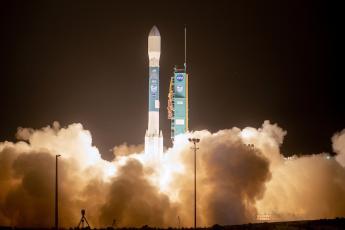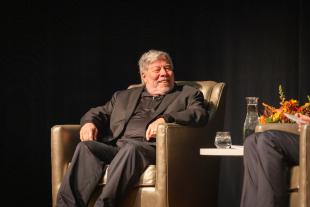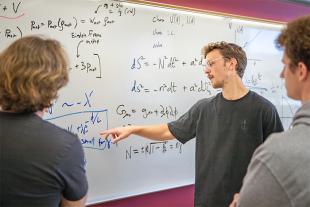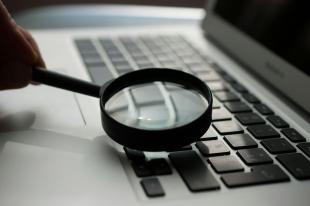Cal Poly Is First University to Sign Agreement to Assist U.S. Strategic Command in Monitoring Objects Orbiting the Earth

Accord formalizes a years-long partnership with Vandenberg-based 18th Space Control Squadron that catalogs and tracks more than 23,000 softball-size objects orbiting at up to 18,000 mph
Cal Poly, which has been at the forefront of small satellite design, build and monitoring, has signed the first agreement between an academic institution and the U.S. Strategic Command to expand an international program tracking tens of thousands of objects in Earth orbit.
Rear Adm. Richard Correll, who oversees plans and policy for U.S. Strategic Command, and Cal Poly President Jeffrey D. Armstrong recently signed the agreement joining more than 100 commercial and foreign nations working together to expand space situational awareness — the ability to monitor, understand and predict natural and manmade objects in orbit around the Earth.
“Academic partnerships such as these provide a foundation for research in space,” said Correll, who since July 2018 has been responsible for a range of issues related to the execution of the command’s global mission. “Improving (space situational awareness), through technical advancements and increased sharing, grows our collective ability to avoid collisions by rapidly detecting, warning, characterizing and attributing natural or man-made phenomena affecting space systems and the space environment.”
Space operations is just one of the responsibilities for the U.S. Strategic Command, or USSTRATCOM. Others include: strategic deterrence; nuclear operations; joint electronic spectrum operations; global strike; missile defense; and analysis and targeting.
Cal Poly already works closely with Air Force Space Command’s 18th Space Control Squadron, located at Vandenberg Air Force Base, that does all the tracking and maintains the space catalog for USSTRATCOM. The squadron tracks more than 23,000 softball-size objects. These include more than 1,300 satellites, the International Space Station, and other items often known as debris that move through space at speeds up to 18,000 mph — more than 20 times the speed of sound.
“Cal Poly is honored to be the first academic institution to enter into an official partnership with U.S. Strategic Command,” Armstrong said. “This first-of-its-kind partnership will allow current and future Cal Poly students to gain hands-on experience working with our four CubeSats currently in orbit and how they affect, and are affected by, other satellites in orbit. These invaluable experiences will prepare our graduates for successful careers in the space and technology industries.”
In the late 1990s, now-emeritus Cal Poly aerospace engineering Professor Jordi Puig-Suari teamed with then-Stanford professor Bob Twiggs to develop the CubeSat standard. Their idea was to give students an opportunity to create small satellites (based on a 4-inch unit) that could hitch a ride as secondary payloads aboard government and commercial space launches.
Hundreds of CubeSats have been launched in the past two decades — from universities across the globe as well as some from high school and middle school programs. Cal Poly is readying its 12th CubeSat — ExoCube 2 — for launch aboard a Virgin Orbit rocket in the next few months. In addition, the Cal Poly CubeSat Lab operates a student-run ground station that monitors and downloads data from satellites passing overhead.
The number of satellites orbiting the Earth is only going to expand.
By the end of 2017, there were more than 1,700 active satellites — some of them the size of a loaf of bread — in orbit, approximately twice as many as there were 15 years ago. Experts estimate that by 2026, at least another 3,000 satellites are expected to be launched: two-thirds for various commercial organizations, and the remainder for civilian and military agencies in more than 60 countries.
Officials are not only concerned by the increasing number of satellites and active payloads, but the amount of debris — rocket bodies, other inert bodies, dead payloads — in Earth orbit, which makes up approximately 95 percent of the objects Vandenberg currently tracks in space.
With a nearly 20-year history of launches and packaging other CubeSats for launch, Cal Poly has developed a solid relationship with officials at Vandenberg.
“We share a lot of data back and forth with the 18th Space Control Squadron,” said Ryan Nugent, a Cal Poly aerospace engineer. “They’re in charge of tracking satellites and providing that data for organizations all over the world. They’ll send us information about potential conjunctions that might involve one of our satellites. A conjunction is when one of our satellites has the possibility of colliding with another satellite. This agreement will make it easier for us to use the services provided by the 18th Space Control Squadron to hopefully reduce the probability of these potential conjunctions actually happening.”
He said students monitoring the ground station in turn share information based on a satellite’s GPS coordinates, which the Vandenberg space monitors input into their tracking system.
Objects entering or exiting space are observed and data is collected from a worldwide network of sensors and analyzed by the 18th Space Control Squadron. The catalog is a record of everything within Earth’s orbit at any given time. Potential collisions between satellites are scrutinized and orbital data is cataloged to provide situational awareness in the space domain.
Cal Poly joins 20 nations — Australia, Japan, Italy, Canada, France, South Korea, the United Kingdom, Germany, Israel, Spain, the United Arab Emirates, Belgium, Norway, Denmark, Brazil, the Netherlands, Thailand, New Zealand, Poland and Romania; two intergovernmental organizations — the European Space Agency and the European Organization for the Exploitation of Meteorological Satellites; and more than 80 commercial satellite owner/operator/launchers already participating in data-sharing agreements with U.S. Strategic Command.
“Universities play a vital role in the exploration and understanding of space,” Correll said. “The future of space is reliant on research and the advancement of technology to enhance overall space-flight safety and the long-term sustainability, stability, safety, and security of the space environment.”
These data-sharing agreements enhance multinational space cooperation and streamline the process for the United States’ partners to request specific information gathered by the 18th Space Control Squadron.
The information is crucial for launch support, satellite maneuver planning, support for on-orbit anomalies, electromagnetic interference reporting and investigation, satellite decommissioning activities and on-orbit conjunction assessments. With the establishment of the 11th combatant command, future space situational awareness agreements will be signed and facilitated by U.S. Space Command.




